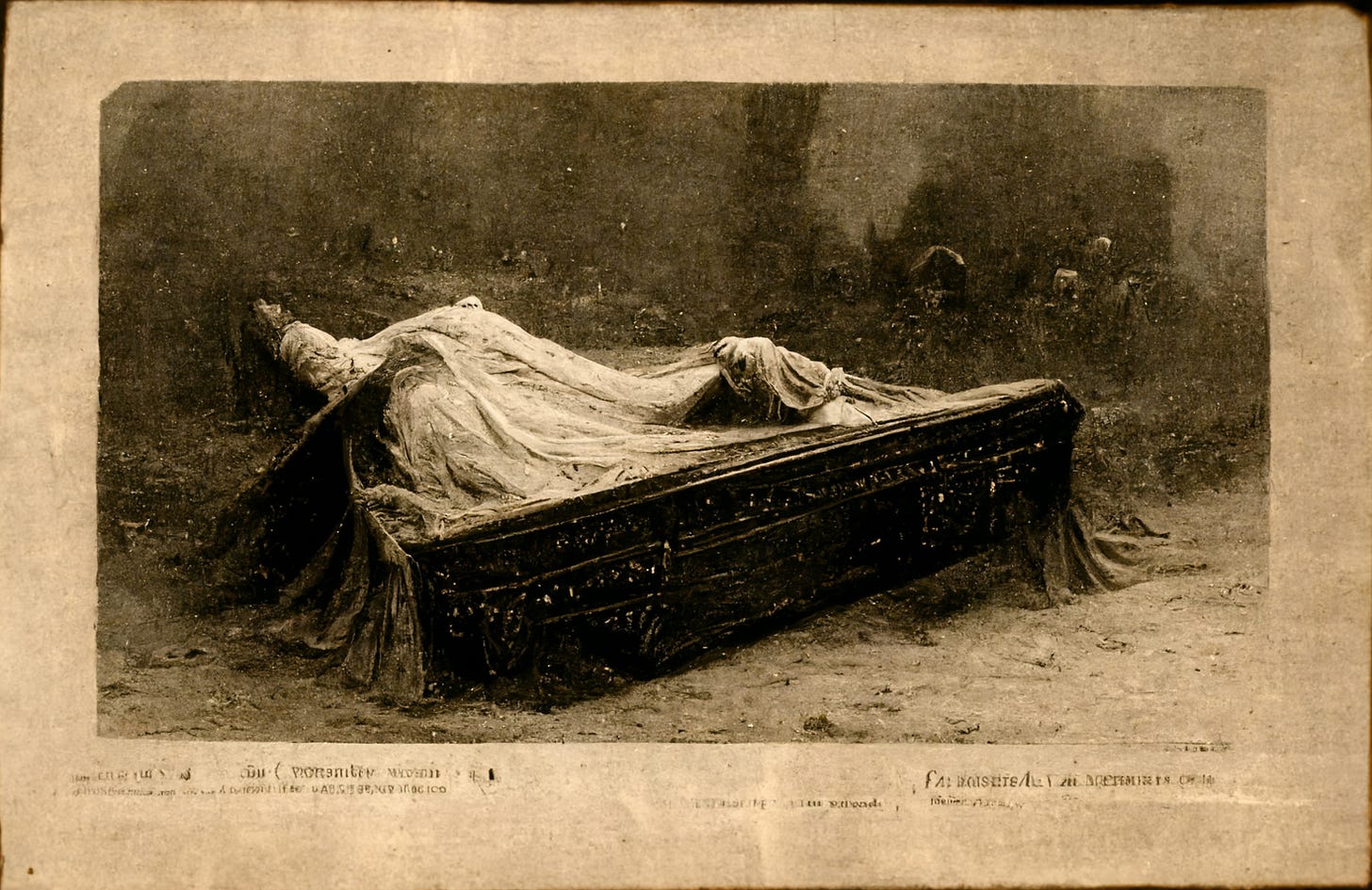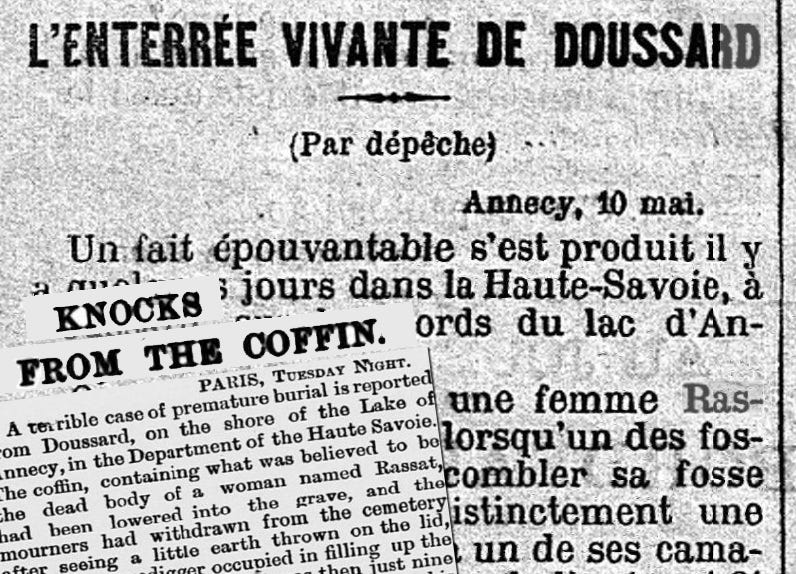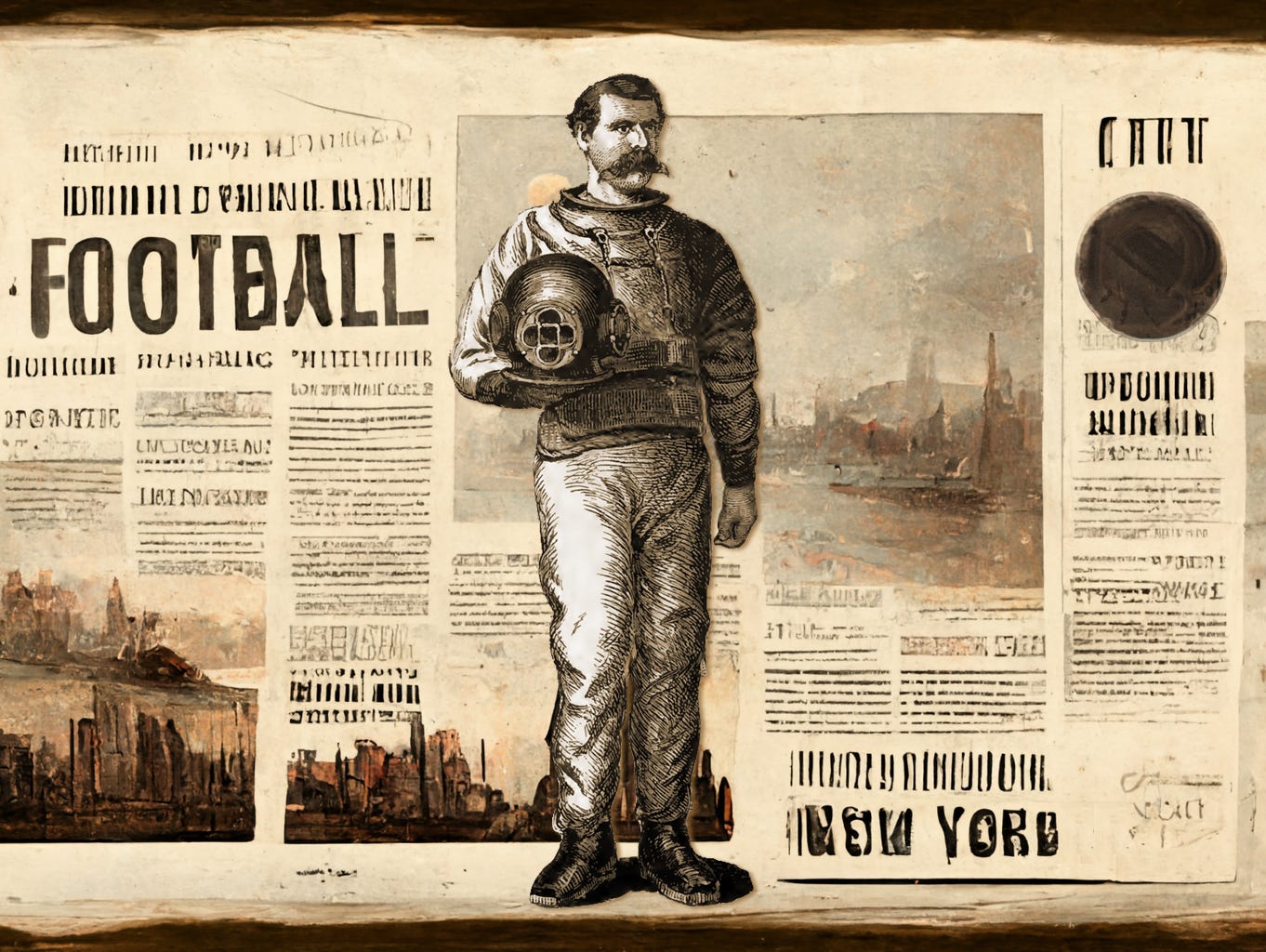Knocks from the Coffin
Buried alive; PLUS mermaids, football, Bonnie and Clyde, and lottery hackers
From southeastern France in 1895, comes the following nightmarish tale:
“A terrible case of premature burial is reported from Doussard, on the shore of the Lake of Annecy, in the Department of the Haute Savoie. The coffin, containing what was believed to be the dead body of a woman named Rassat, had been lowered into the grave, and the mourners had withdrawn from the cemetery after seeing a little earth thrown on the lid when the gravedigger occupied in filling up the grave heard a knocking. It was then just nine o'clock in the morning.”
“Calling one of his fellow workmen, the two men listened to the continued knocking in the coffin for half an hour, before they made up their minds to do anything, and then, instead of breaking open the coffin lid to release the unfortunate person within it, they went to warn the authorities. The parish priest was the first to arrive, but even that enlightened individual was careful not to open the coffin because the local authorization to exhume the body had not been given. All he did was to bore a few holes with a small gimlet in the lid to let in a little air.”
“At length, three hours after the noise in the coffin was first heard, all the legal formalities had been accomplished. The knocking had already ceased a few minutes, but the lid was at last removed. Whether Madame Rassat was alive at that moment does not appear very certain, but some of the persons present affirm that her cheeks flushed and her eyes half opened when the coffin lid was removed. What is a fact is that when, after a further delay of no less than six hours and a half, Dr. Estay was summoned, he asserted that Madame Rassat, who had been buried early in the morning, had not been really dead more than six hours; that is to say, at about the moment the coffin lid was removed.”
There is much to ponder here. The gravediggers waited half an hour before deciding to do anything, and even then didn’t open the coffin. Neither did the parish priest, who did however make some air holes with his little gimlet. It was three hours before the lid was removed, and six and a half hours before the doctor was summoned. Quicker action might well have saved her life. The story was reported in Paris, in Le Figaro, whose correspondent E.M. concluded: “Madame Rassat, having been buried alive, was left all that time to die.”
While the gruesome tale might seem like one that must be confined to the annals of gothic history, the unfortunate phenomenon of being buried alive has continued into the modern era. The always-excellent Fortean Times magazine publishes a regular round-up of premature burials. Most recently, in its August issue, the magazine reported the tragic story from May of this year of Rosa Isabel Cespedes Callaca, who was buried following a terrible car accident in Peru. Mourners at her funeral were horrified to hear banging from inside her coffin. The lid was opened and Callaca was found to be breathing and had opened her eyes. Unfortunately, although she was rushed to hospital, Callaca’s resurrection was short-lived, and she died a few hours later.
Also from May, Fortean Times highlights a story from the Times newspaper about two undertakers who were dispatched to collect the body of a 75-year-old woman who had died of Covid-19 at a care home in Shanghai. The woman had been declared dead by a doctor, and her body had been disinfected and sealed in a body bag. But when the undertakers lifted the body bag, they felt the body move. Ordering the care home staff to open the bag, the undertakers found that the woman was still alive. She was rushed to hospital, and was reported to be in stable condition. The undertakers received a cash reward for saving the woman’s life, but the care home director and the doctor were both given the boot.⬧
Now something new(ish) from me:
Arthur Pember: The Mermaid Hunter Who Invented Football
In the spring of 1872, the intrepid New York journalist Arthur Pember plunged into the cold and murky waters off Manhattan in search of mermaids. Pember was no stranger to adventure. As an undercover reporter, he investigated and exposed injustice, crime, and corruption during the “Gangs of New York” era for the city’s leading newspapers. But he never wrote about his previous life, back on the other side of the Atlantic, as the first president of the English Football Association and the inventor of the rules of the world’s favorite sport.
This is a piece I originally wrote for Howler magazine, now available to read on Medium’s Soccer Stories ad-free and outside of the paywall. It’s a wild story, one of those that you can’t quite believe hasn’t been told before. It’s a long read, 24 minutes according to Medium, so grab a cuppa and settle in (or click the “listen” button and have Medium read it to you). You can read it (or listen to it) here.
(As featured in the latest edition of the indispensable Sunday Long Reads newsletter!)
A couple of other reading recommendations:
Getaway Driver by Lauren Hough (Texas Highways, March 2022)
I’ve been wanting to recommend this for a while. Lauren Hough heads into the Texas panhandle to investigate a story told to her by her grandfather. Did Bonnie and Clyde really hide out in his barn and reward him with a box of Hershey’s chocolate? It’s a great piece about searching for truth in family history, and of course in the end it’s not really about Bonnie and Clyde at all. You can read the story here. (Writers and other interested parties might like to read the annotated version at Nieman Storyboard.)
Jerry and Marge Go Large by Jason Fagone (HuffPost Highline, January 2018)
We recently watched the movie version of Jerry and Marge Go Large starring Bryan Cranston and Annette Bening. It’s about a retired couple who find a loophole in the state lottery and use their winnings to benefit the lives of their friends and their community. It’s a fun, feel-good film (and Cranston and Bening are great). But it sent me back to the original article from 2018 by Jason Fagone. It’s one of my favourite longform stories, and you can read it here (before or after watching the movie).
(By coincidence, Jason also wrote The Jessica Simulation, as recommended in the previous AI-focused newsletter.)
Just before I go, a quick reminder that my book, The Tyne Bridge, will be published by Hurst on 3 November. There’s a little website here with some more info and links to place pre-orders. Pre-orders are really important for authors, so if you think you’d like to read it (or you think the copiously-illustrated hardback book might make a nice Christmas present…) please do order it as soon as you can with your bookseller of choice. You can order online or ask your local bookshop to order it for you, and it will be delivered when published. Thank you! For more info click here.
More singular stuff next time. See ya.
Sources: London Evening Standard, 15 May 1895; Le Figaro, 11 May 1895
Note: Although this edition of the newsletter was written by a human (me!), the illustration at the top of the page was generated by the Midjourney AI bot. I may use more AI-generated images where photos are not available as they seem more interesting than images of newspaper clippings. Let me know what you think. And if you missed the AI-generated edition of the newsletter, you can read it here.
Enjoy the read? Reward the writer.
This newsletter is published ad-free, subscription-free, and outside of any paywall. We hope you enjoyed it. We believe writers deserve fair payment for quality content. We ask every reader to consider tipping the cost of a cup of coffee for this newsletter. All Ko-fi payments go directly to the writer. Thank you for your support. Click to tip.









